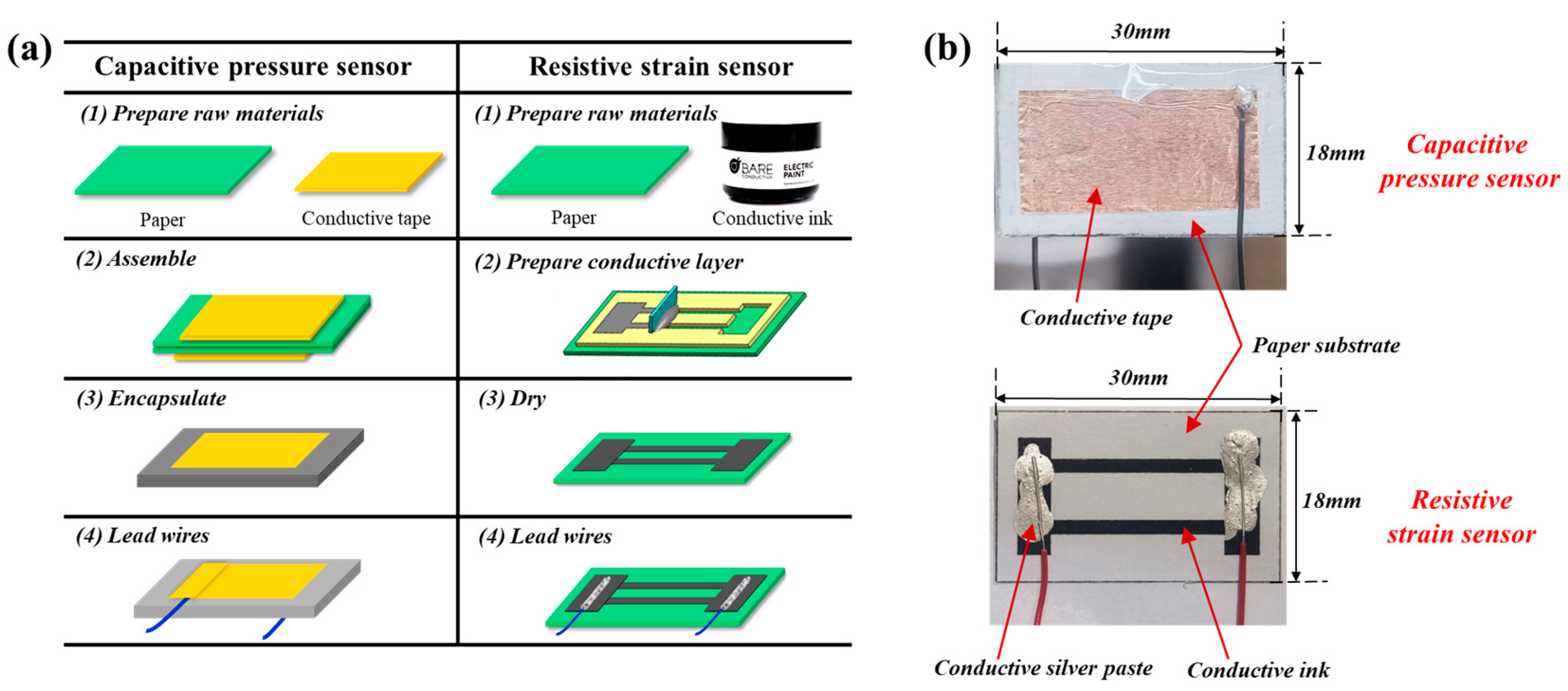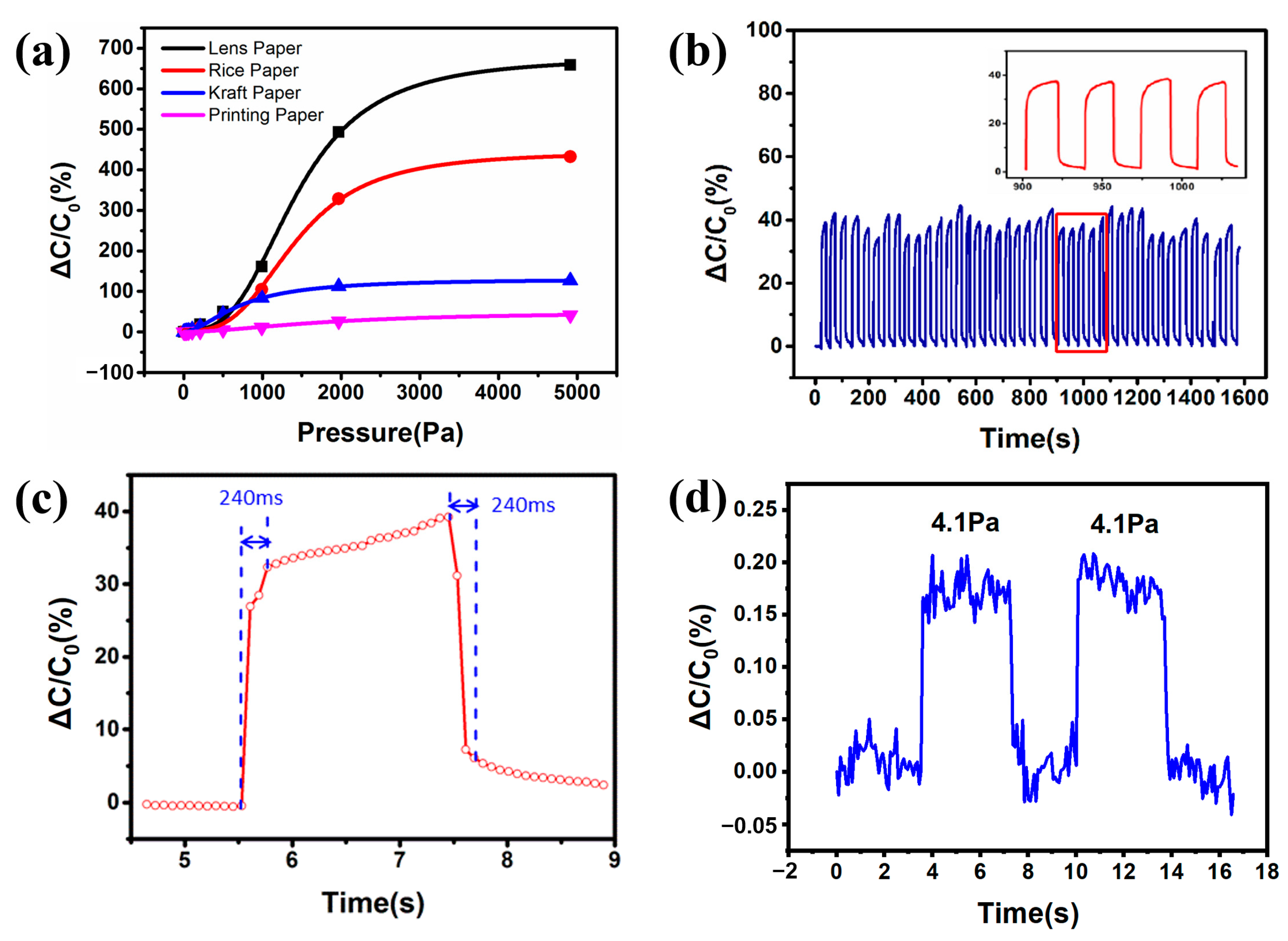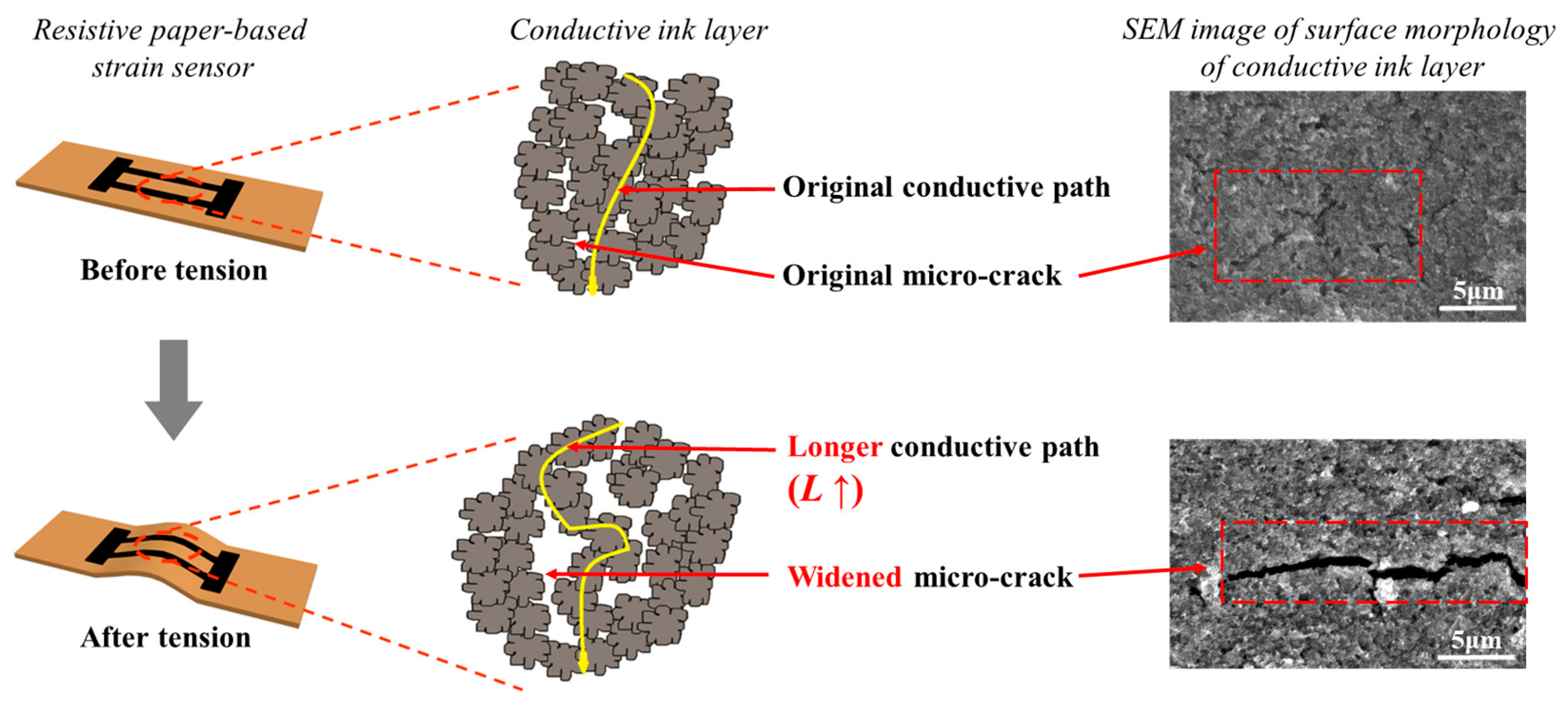Highly Sensitive Paper-Based Force Sensors with Natural Micro-Nanostructure Sensitive Element
Abstract
1. Introduction
2. Experimental Section
2.1. Device Fabrication
2.2. Characterization and Measurement
3. Results and Discussion
3.1. Capacitive Paper-Based Pressure Sensor
3.1.1. Micro-Nanostructure Characterization and Sensing Principle
3.1.2. Sensor Performance Testing
3.2. Resistive Paper-Based Strain Sensor
3.2.1. Micro-Nanostructure Characterization and Sensing Principle
3.2.2. Sensor Performance Testing
4. Conclusions
Supplementary Materials
Author Contributions
Funding
Data Availability Statement
Conflicts of Interest
References
- Luo, Y.F.; Abidian, M.R.; Ahn, J.H.; Akinwande, D.; Andrews, A.M.; Antonietti, M.; Bao, Z.N.; Berggren, M.; Berkey, C.A.; Bettinger, C.J.; et al. Technology Roadmap for Flexible Sensors. ACS Nano 2023, 17, 5211–5295. [Google Scholar] [CrossRef]
- He, S.; Zhang, Y.; Gao, J.R.; Nag, A.; Rahaman, A. Integration of Different Graphene Nanostructures with PDMS to Form Wearable Sensors. Nanomaterials 2022, 12, 950. [Google Scholar] [CrossRef]
- Wang, Z.W.; Cong, Y.; Fu, J. Stretchable and tough conductive hydrogels for flexible pressure and strain sensors. J. Mater. Chem. B 2020, 8, 3437–3459. [Google Scholar] [CrossRef]
- Pyo, S.; Lee, J.; Bae, K.; Sim, S.; Kim, J. Recent Progress in Flexible Tactile Sensors for Human-Interactive Systems: From Sensors to Advanced Applications. Adv. Mater. 2021, 33, 2005902. [Google Scholar] [CrossRef]
- Cao, X.L.; Xiong, Y.; Sun, J.; Zhu, X.X.; Sun, Q.J.; Wang, Z.L. Piezoelectric Nanogenerators Derived Self-Powered Sensors for Multifunctional Applications and Artificial Intelligence. Adv. Funct. Mater. 2021, 31, 2102983. [Google Scholar] [CrossRef]
- Duan, L.Y.; D’Hooge, D.R.; Cardon, L. Recent progress on flexible and stretchable piezoresistive strain sensors: From design to application. Prog. Mater. Sci. 2020, 114, 100617. [Google Scholar] [CrossRef]
- Khalid, M.A.U.; Chang, S.H. Flexible strain sensors for wearable applications fabricated using novel functional nanocomposites: A review. Compos. Struct. 2022, 284, 115214. [Google Scholar] [CrossRef]
- Chang, H.; Kim, S.; Jin, S.; Lee, S.W.; Yang, G.T.; Lee, K.Y.; Yi, H. Ultrasensitive and Highly Stable Resistive Pressure Sensors with Biomaterial-Incorporated Interfacial Layers for Wearable Health-Monitoring and Human-Machine Interfaces. ACS Appl. Mater. Interfaces 2018, 10, 1067–1076. [Google Scholar] [CrossRef] [PubMed]
- Chen, Y.W.; Pancham, P.P.; Mukherjee, A.; Martincic, E.; Lo, C.Y. Recent advances in flexible force sensors and their applications: A review. Flex. Print. Electron. 2022, 7, 033002. [Google Scholar] [CrossRef]
- Rim, Y.S.; Bae, S.H.; Chen, H.J.; De Marco, N.; Yang, Y. Recent Progress in Materials and Devices toward Printable and Flexible Sensors. Adv. Mater. 2016, 28, 4415–4440. [Google Scholar] [CrossRef] [PubMed]
- Verpoorten, E.; Massaglia, G.; Ciardelli, G.; Pirri, C.F.; Quaglio, M. Design and Optimization of Piezoresistive PEO/PEDOT:PSS Electrospun Nanofibers for Wearable Flex Sensors. Nanomaterials 2020, 10, 2166. [Google Scholar] [CrossRef]
- Chen, L.R.; Chang, X.H.; Wang, H.; Chen, J.W.; Zhu, Y.T. Stretchable and transparent multimodal electronic-skin sensors in detecting strain, temperature, and humidity. Nano Energy 2022, 96, 107077. [Google Scholar] [CrossRef]
- Chen, J.W.; Zhu, Y.T.; Chang, X.H.; Pan, D.; Song, G.; Guo, Z.H.; Naik, N. Recent Progress in Essential Functions of Soft Electronic Skin. Adv. Funct. Mater. 2021, 31, 2104686. [Google Scholar] [CrossRef]
- Jeong, S.Y.; Lee, J.U.; Hong, S.M.; Lee, C.W.; Hwang, S.H.; Cho, S.C.; Shin, B.S. Highly Skin-Conformal Laser-Induced Graphene-Based Human Motion Monitoring Sensor. Nanomaterials 2021, 11, 951. [Google Scholar] [CrossRef] [PubMed]
- An, N.L.; Qin, J.X.; Zhou, X.; Wang, Q.D.; Fang, C.Q.; Guo, J.P.; Nan, B. Recent Progress in Cellulose-Based Flexible Sensors. J. Renew. Mater. 2022, 10, 2319–2334. [Google Scholar] [CrossRef]
- Chen, S.C.; Wang, Y.F.; Yang, L.; Guo, Y.J.; Wang, M.; Sun, K. Flexible and transparent sensors with hierarchically micro-nano texture for touchless sensing and controlling. Nano Energy 2021, 82, 105719. [Google Scholar] [CrossRef]
- Lin, M.Z.; Zheng, Z.J.; Yang, L.; Luo, M.S.; Fu, L.H.; Lin, B.F.; Xu, C.H. A High-Performance, Sensitive, Wearable Multifunctional Sensor Based on Rubber/CNT for Human Motion and Skin Temperature Detection. Adv. Mater. 2022, 34, 2107309. [Google Scholar] [CrossRef]
- Jia, M.L.; Yi, C.H.; Han, Y.K.; Wang, L.; Li, X.; Xu, G.L.; He, K.; Li, N.C.; Hou, Y.X.; Wang, Z.G.; et al. Hierarchical Network Enabled Flexible Textile Pressure Sensor with Ultrabroad Response Range and High-Temperature Resistance. Adv. Sci. 2022, 9, e2105738. [Google Scholar] [CrossRef] [PubMed]
- Kumaresan, Y.; Ma, S.H.; Ozioko, O.; Dahiya, R. Soft Capacitive Pressure Sensor With Enhanced Sensitivity Assisted by ZnO NW Interlayers and Airgap. IEEE Sens. J. 2022, 22, 3974–3982. [Google Scholar] [CrossRef]
- Zazoum, B.; Batoo, K.M.; Khan, M.A.A. Recent Advances in Flexible Sensors and Their Applications. Sensors 2022, 22, 4653. [Google Scholar] [CrossRef]
- Han, F.; Li, M.; Ye, H.Y.; Zhang, G.Q. Materials, Electrical Performance, Mechanisms, Applications, and Manufacturing Approaches for Flexible Strain Sensors. Nanomaterials 2021, 11, 1220. [Google Scholar] [CrossRef]
- Zhu, Y.J. Multifunctional Fire-Resistant Paper Based on Ultralong Hydroxyapatite Nanowires. Chin. J. Chem. 2021, 39, 2296–2314. [Google Scholar] [CrossRef]
- Tai, H.L.; Duan, Z.H.; Wang, Y.; Wang, S.; Jiang, Y.D. Paper-Based Sensors for Gas, Humidity, and Strain Detections: A Review. ACS Appl. Mater. Interfaces 2020, 12, 31037–31053. [Google Scholar] [CrossRef] [PubMed]
- Korotcenkov, G. Paper-Based Humidity Sensors as Promising Flexible Devices: State of the Art: Part 1. General Consideration. Nanomaterials 2023, 13, 1110. [Google Scholar] [CrossRef] [PubMed]
- Mishra, R.B.; El-Atab, N.; Hussain, A.M.; Hussain, M.M. Recent Progress on Flexible Capacitive Pressure Sensors: From Design and Materials to Applications. Adv. Mater. Technol. 2021, 6, 2001023. [Google Scholar] [CrossRef]
- Xu, Y.D.; Fei, Q.H.; Page, M.; Zhao, G.G.; Ling, Y.; Stoll, S.B.; Yan, Z. Paper-based wearable electronics. Iscience 2021, 24, 102736. [Google Scholar] [CrossRef] [PubMed]
- Selamneni, V.; Ganeshan, S.K.; Nerurkar, N.; Akshaya, T.; Sahatiya, P. Facile Fabrication of MoSe2 on Paper as an Electromechanical Piezoresistive Pressure-Strain Sensor. IEEE Trans. Instrum. Meas. 2021, 70, 6002408. [Google Scholar] [CrossRef]
- Tao, L.Q.; Zhang, K.N.; Tian, H.; Liu, Y.; Wang, D.Y.; Chen, Y.Q.; Yang, Y.; Ren, T.L. Graphene-Paper Pressure Sensor for Detecting Human Motions. ACS Nano 2017, 11, 8790–8795. [Google Scholar] [CrossRef]
- Lee, K.; Lee, J.; Kim, G.; Kim, Y.; Kang, S.; Cho, S.; Kim, S.; Kim, J.K.; Lee, W.; Kim, D.E.; et al. Rough-Surface-Enabled Capacitive Pressure Sensors with 3D Touch Capability. Small 2017, 13, 1700368. [Google Scholar] [CrossRef]
- Liu, H.B.; Xiang, H.C.; Wang, Y.; Li, Z.J.; Qian, L.W.; Li, P.; Ma, Y.C.; Zhou, H.W.; Huang, W. A Flexible Multimodal Sensor That Detects Strain, Humidity, Temperature, and Pressure with Carbon Black and Reduced Graphene Oxide Hierarchical Composite on Paper. ACS Appl. Mater. Interfaces 2019, 11, 40613–40619. [Google Scholar] [CrossRef]
- Gullapalli, H.; Vemuru, V.S.M.; Kumar, A.; Botello-Mendez, A.; Vajtai, R.; Terrones, M.; Nagarajaiah, S.; Ajayan, P.M. Flexible Piezoelectric ZnO-Paper Nanocomposite Strain Sensor. Small 2010, 6, 1641–1646. [Google Scholar] [CrossRef]
- Huang, Y.C.; Liu, Y.; Ma, C.; Cheng, H.C.; He, Q.Y.; Wu, H.; Wang, C.; Lin, C.Y.; Huang, Y.; Duan, X.F. Sensitive pressure sensors based on conductive microstructured air-gap gates and two-dimensional semiconductor transistors. Nat. Electron. 2020, 3, 59–69. [Google Scholar] [CrossRef]
- Chen, Z.H.; Hu, Y.J.; Zhuo, H.; Liu, L.X.; Jing, S.S.; Zhong, L.X.; Peng, X.W.; Sun, R.C. Compressible, Elastic, and Pressure-Sensitive Carbon Aerogels Derived from 2D Titanium Carbide Nanosheets and Bacterial Cellulose for Wearable Sensors. Chem. Mater. 2019, 31, 3301–3312. [Google Scholar] [CrossRef]
- Zhai, J.Y.; Zhang, Y.; Cui, C.; Li, A.; Wang, W.J.; Guo, R.H.; Qin, W.F.; Ren, E.H.; Xiao, H.Y.; Zhou, M. Flexible Waterborne Polyurethane/Cellulose Nanocrystal Composite Aerogels by Integrating Graphene and Carbon Nanotubes for a Highly Sensitive Pressure Sensor. ACS Sustain. Chem. Eng. 2021, 9, 14029–14039. [Google Scholar] [CrossRef]
- Zhang, H.; Sun, X.H.; Hubbe, M.A.; Pal, L. Flexible and Pressure-Responsive Sensors from Cellulose Fibers Coated with Multiwalled Carbon Nanotubes. ACS Appl. Electron. Mater. 2019, 1, 1179–1188. [Google Scholar] [CrossRef]
- Luo, M.Y.; Li, M.F.; Li, Y.Q.; Chang, K.Q.; Liu, K.; Liu, Q.Z.; Wang, Y.D.; Lu, Z.T.; Liu, X.; Wang, D. In-situ polymerization of PPy/cellulose composite sponge with high elasticity and conductivity for the application of pressure sensor. Compos. Commun. 2017, 6, 68–72. [Google Scholar] [CrossRef]
- Wang, S.; Xiang, J.; Sun, Y.G.; Wang, H.L.; Du, X.S.; Cheng, X.; Du, Z.L.; Wang, H.B. Skin-inspired nanofibrillated cellulose-reinforced hydrogels with high mechanical strength, long-term antibacterial, and self-recovery ability for wearable strain/pressure sensors. Carbohydr. Polym. 2021, 261, 117894. [Google Scholar] [CrossRef]
- Hosseini, H.; Kokabi, M.; Mousavi, S.M. Conductive bacterial cellulose/multiwall carbon nanotubes nanocomposite aerogel as a potentially flexible lightweight strain sensor. Carbohydr. Polym. 2018, 201, 228–235. [Google Scholar] [CrossRef]
- Zhang, H.T.; Wu, X.J.; Qin, Z.H.; Sun, X.; Zhang, H.; Yu, Q.Y.; Yao, M.M.; He, S.S.; Dong, X.R.; Yao, F.L.; et al. Dual physically cross-linked carboxymethyl cellulose-based hydrogel with high stretchability and toughness as sensitive strain sensors. Cellulose 2020, 27, 9975–9989. [Google Scholar] [CrossRef]
- Huang, J.Y.; Zhao, M.; Cai, Y.B.; Zimniewska, M.; Li, D.W.; Wei, Q.F. A Dual-Mode Wearable Sensor Based on Bacterial Cellulose Reinforced Hydrogels for Highly Sensitive Strain/Pressure Sensing. Adv. Electron. Mater. 2020, 6, 1900934. [Google Scholar] [CrossRef]
- Li, M.F.; Tu, Q.Y.; Long, X.; Zhang, Q.T.; Jiang, H.R.; Chen, C.Z.; Wang, S.F.; Min, D.Y. Flexible conductive hydrogel fabricated with polyvinyl alcohol, carboxymethyl chitosan, cellulose nanofibrils, and lignin-based carbon applied as strain and pressure sensor. Int. J. Biol. Macromol. 2021, 166, 1526–1534. [Google Scholar] [CrossRef] [PubMed]






Disclaimer/Publisher’s Note: The statements, opinions and data contained in all publications are solely those of the individual author(s) and contributor(s) and not of MDPI and/or the editor(s). MDPI and/or the editor(s) disclaim responsibility for any injury to people or property resulting from any ideas, methods, instructions or products referred to in the content. |
© 2024 by the authors. Licensee MDPI, Basel, Switzerland. This article is an open access article distributed under the terms and conditions of the Creative Commons Attribution (CC BY) license (https://creativecommons.org/licenses/by/4.0/).
Share and Cite
Zhang, H.; Ren, Y.; Zhu, J.; Jia, Y.; Liu, Q.; Yang, X. Highly Sensitive Paper-Based Force Sensors with Natural Micro-Nanostructure Sensitive Element. Nanomaterials 2024, 14, 358. https://doi.org/10.3390/nano14040358
Zhang H, Ren Y, Zhu J, Jia Y, Liu Q, Yang X. Highly Sensitive Paper-Based Force Sensors with Natural Micro-Nanostructure Sensitive Element. Nanomaterials. 2024; 14(4):358. https://doi.org/10.3390/nano14040358
Chicago/Turabian StyleZhang, Haozhe, Yuyu Ren, Junwen Zhu, Yanshen Jia, Qiang Liu, and Xing Yang. 2024. "Highly Sensitive Paper-Based Force Sensors with Natural Micro-Nanostructure Sensitive Element" Nanomaterials 14, no. 4: 358. https://doi.org/10.3390/nano14040358
APA StyleZhang, H., Ren, Y., Zhu, J., Jia, Y., Liu, Q., & Yang, X. (2024). Highly Sensitive Paper-Based Force Sensors with Natural Micro-Nanostructure Sensitive Element. Nanomaterials, 14(4), 358. https://doi.org/10.3390/nano14040358







